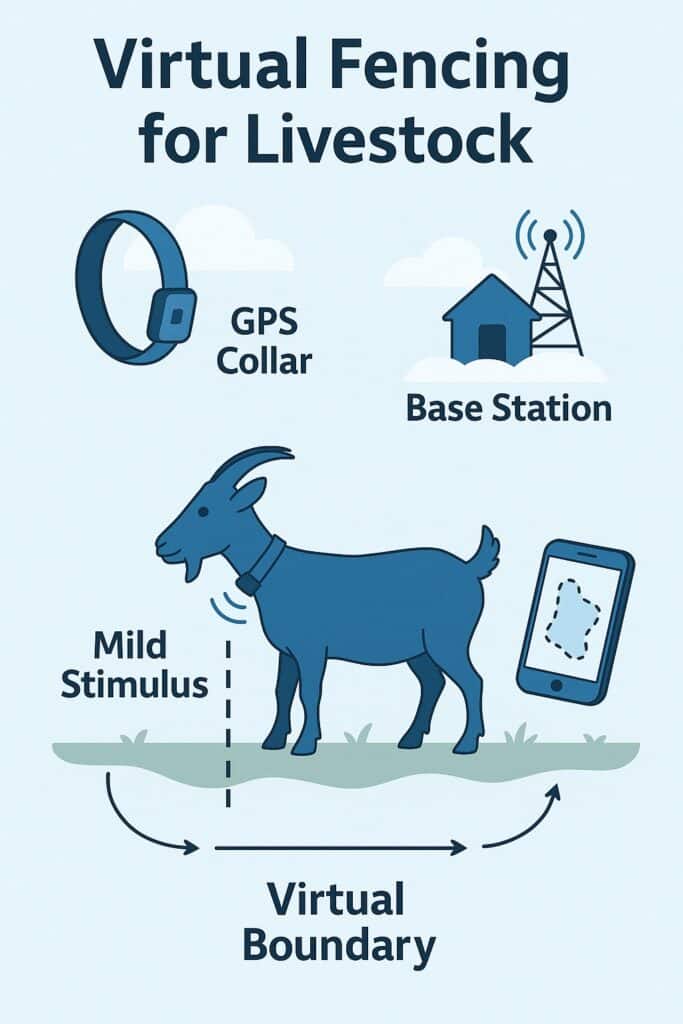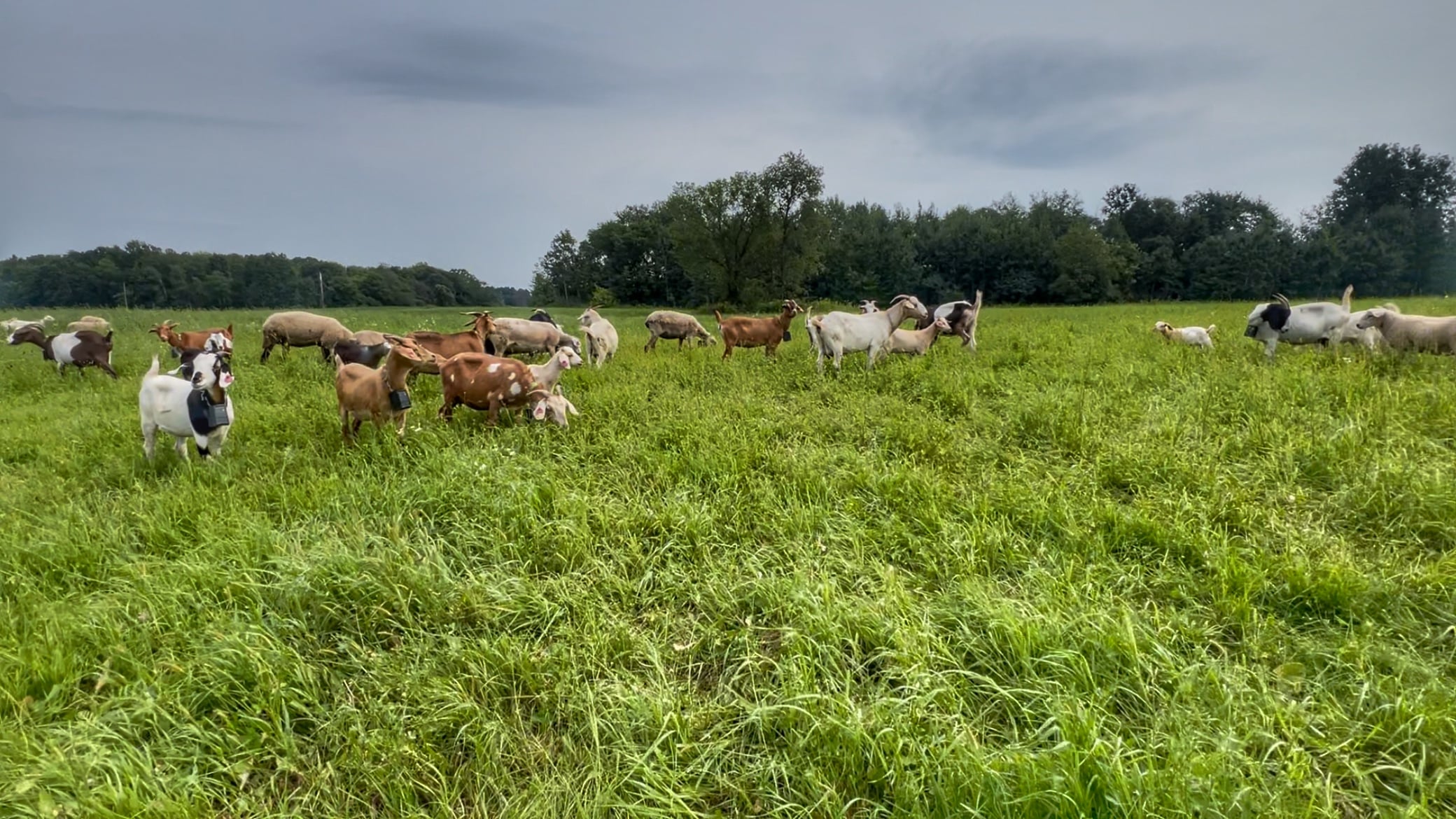When you think about fencing livestock, the first thing that comes to mind is probably miles of wire, posts, and gates. But there’s a newer livestock management tool that’s becoming more commonplace with farmers and ranchers: virtual fencing.
While it can fully replace physical fence, it doesn’t necessarily need to be the situation. It can be another option in your grazing toolbox. Here’s a big-picture look at what a virtual fence is, how it works, and what it might mean for managing goats, sheep and cattle.
Table of contents
- What is a virtual fence?
- The technology behind virtual fencing
- How farmers and ranchers use virtual fences
- Potential benefits
- Challenges to consider before using a virtual fence
- Virtual fence system brand options
- The future of virtual fencing
- Vlog: Setting up virtual fence on our goat farm
- Related blog posts
What is a virtual fence?
A virtual fence uses GPS-enabled collars (or in some cases, ear tags) to set boundaries for livestock without needing an actual physical fence. Instead of running polywire or moving netting, you draw the fence line digitally using a phone, tablet, or computer.
When an animal approaches the boundary, the collar gives an audio cue first. If the animal keeps going, it delivers a mild, short stimulus, just enough to encourage them to turn back. Over time, most livestock, including goats and sheep, learn to respond to the sound cue alone.
One important animal welfare feature: if an animal crosses the boundary, most systems allow livestock to return without getting another correction, which reduces stress and helps with training.

The technology behind virtual fencing
Here’s how many virtual fence systems include:
- GPS tracking: generally accurate to about 10–35 feet.
- Communication technology: cellular, satellite, or radio signals connect the collars to a base station or cloud-based software. Some systems can operate offline for periods between updates.
- Control software or an app: set and change boundaries in real time.
This three-part setup, collars, a communication base, and a digital interface, is the backbone of most systems. Battery life varies, and some collars have solar panels to extend run time, which is especially helpful in remote grazing areas.
How farmers and ranchers use virtual fences
Virtual fencing can work for a variety of livestock grazing operations:
- Rotational grazing for cattle, goats, and sheep without moving temporary fencing every few days to daily or even multiple times a day.
- Keeping animals out of sensitive areas like streams, wetlands, or new plantings.
- Managing remote pastures, rangeland or woods where traditional fencing isn’t practical.
- Grazing rugged, hard-to-fence terrain.
- Setting seasonal grazing plans or short-term exclusion zones to rest a pasture.
- Using on leased land where permanent fence isn’t allowed or cost-effective.
There has been a number of research studies and on farm trials that have studied the use of goats with virtual fence, primarly using Nofence, that includes additional information on best practices for using this technology.
Potential benefits
- Time and labor savings from less fence building and moving.
- Flexible management: adjust grazing boundaries with a few clicks.
- Better pasture utilization by fine-tuning grazing pressure.
- Environmental protection by keeping animals out of erosion-prone or sensitive zones.
- Wildlife-friendly grazing: fewer physical barriers in the landscape.
- Access to hard-to-reach areas that might otherwise go unused.
- Data insights like movement patterns, grazing habits, and location history.
- Real-time alerts for escapes or unusual behavior, which can help identify sick livestock sooner.
Challenges to consider before using a virtual fence
Like any technology, a virtual fence isn’t a silver bullet. There are some challenges or downsides that may come with it, such as:
- Upfront cost for collars and ongoing subscription or service fees.
- Reliability: collars need good signal coverage and regular charging (solar helps).
- Learning curve: setting up boundaries, learning the software, and integrating it into your grazing plan takes time.
- Collar deployment: there can be a delay when working with animals, such as putting on new collars and setting new paddocks.
- Maintenance: collars may need periodic adjustment as animals grow, and failures can happen from damage or water intrusion.
- Acceptable containment levels: no fence (physical or virtual) is 100% perfect.
- Animal welfare and public perception: be ready to explain how it works and why it’s safe.
- Regulations: check local rules to make sure it’s approved in your area.
- External interference: sometimes obstructions like buildings or even issues out of our control, such as satellite issues or solar storm interference, can cause blips in service or unexpected situations.
Virtual fence system brand options
As of 2025, the main commercial systems in the U.S. include:
Each system offers different features, service plans, and pricing. Some producers have been able to use USDA-NRCS cost-share programs to help with the investment. This option may be dependent on state NRCS funding and interpretation of conservation programs. Always talk with your county conservationist first before assuming a practice, such as virtual fencing, may qualify for a program like EQIP.
We are currently using Nofence on our goat and sheep farm. I’ve heard good things about Gallagher’s eShepherd technology, but it is not available yet for small ruminants.
Note: If you’re interested in a 10% discount code on Nofence collars, just email me at hello@cylonrollingacres.com with the subject line Nofence code, and I’d be happy to share code at no cost to you, just savings.
The future of virtual fencing
Virtual fence technology is evolving quickly. Expect to see:
- Longer battery life and better solar charging.
- Smarter and smaller collars/batteries.
- More integration with health and activity sensors.
- AI-driven grazing recommendations based on animal movement and pasture conditions.
A virtual fence isn’t here to replace all your existing fences, but it can add flexibility, efficiency, and better pasture management for cattle, goats, and sheep. If you’re thinking about using the system, start by learning how the specific technology works, what it costs, how it might work with your farm/ranch, and talk with others who are using it. That way you can determine if it’s a fit for your operation and worth the investment.

LEAVE A COMMENT
Comments